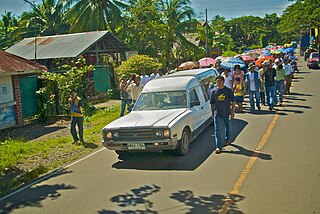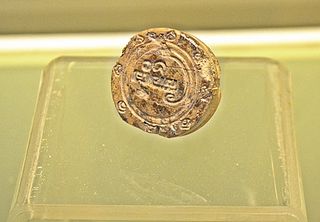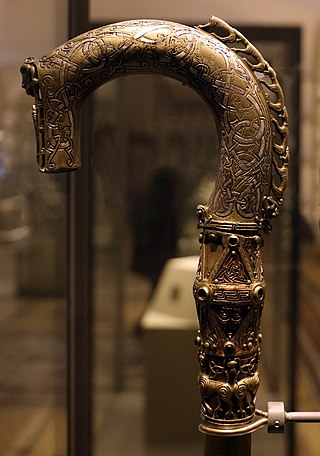
Saqqara, also spelled Sakkara or Saccara in English, is an Egyptian village in the markaz (county) of Badrashin in the Giza Governorate, that contains ancient burial grounds of Egyptian royalty, serving as the necropolis for the ancient Egyptian capital, Memphis. Saqqara contains numerous pyramids, including the Pyramid of Djoser, sometimes referred to as the Step Tomb, and a number of mastaba tombs. Located some 30 km (19 mi) south of modern-day Cairo, Saqqara covers an area of around 7 by 1.5 km.

A ship burial or boat grave is a burial in which a ship or boat is used either as the tomb for the dead and the grave goods, or as a part of the grave goods itself. If the ship is very small, it is called a boat grave. This style of burial was practiced by various seafaring cultures in Asia and Europe. Notable ship burial practices include those by the Germanic peoples, particularly by Viking Age Norsemen, as well as the pre-colonial ship burials described in the Boxer Codex in the Philippines.

Butuan, officially the City of Butuan, is a 1st class highly urbanized city in the region of Caraga, Philippines. It is the de facto capital of the province of Agusan del Norte where it is geographically situated but has an administratively independent government. According to the 2020 census, it has a population of 372,910 people.
Buddhism is a minor religion in the Philippines. In 2016, Buddhism was practiced by around 2% of the population, according to the Permanent Mission of the Republic of the Philippines to the United Nations.

The Agusan image is a 2 kg (4.4 lb), 21-karat gold statuette, found in 1917 on the banks of the Wawa River near Esperanza, Agusan del Sur, Mindanao in the Philippines, dating to the 9th–10th centuries. The figure, approximately 178 mm (7.0 in) in height, is of a female Hindu or Buddhist deity, seated cross-legged and wearing a richly-adorned headdress and other ornaments on various parts of the body. It is now on display in the Field Museum of Natural History in Chicago.
The Arts in the Philippines are all the arts in the Philippines, from the beginning of civilization to the present. They reflect a range of artistic influences on the country's culture, including indigenous art. Philippine art consists of two branches: traditional and non-traditional art. Each branch is divided into categories and subcategories.

Piloncitos are small "bead-like" pieces of gold which were used as currency during the Philippines' Archaic period and in the earliest years of the country's Spanish colonial period. These gold pieces have been excavated from sites throughout the Philippine archipelago: Mandaluyong, Bataan, the banks of the Pasig River, Batangas, and Marinduque in Luzon; Samar and Leyte in the Visayas; and in some areas in Mindanao.

Butuan, also called the Butan Rajanate and the Kingdom of Butuan, was a precolonial Bisaya polity (lungsod) centered around northeastern Mindanao island in present-day Butuan, Philippines. It was known for its gold mining, gold jewelry and other wares, and its extensive trade network across maritime Southeast Asia and elsewhere. Over its long history the lungsod had direct trading relationships with the ancient civilizations of China, Champa, Đại Việt, Pon-i (Brunei), Srivijaya, Majapahit, Kambuja, and areas now comprised in Thailand.

The prehistory of the Philippines covers the events prior to the written history of what is now the Philippines. The current demarcation between this period and the early history of the Philippines is April 21, 900, which is the equivalent on the Proleptic Gregorian calendar for the date indicated on the Laguna Copperplate Inscription—the earliest known surviving written record to come from the Philippines. This period saw the immense change that took hold of the archipelago from Stone Age cultures in 50000 BC to the emergence of developed thalassocratic civilizations in the fourth century, continuing on with the gradual widening of trade until 900 and the first surviving written records.

A balangay, or barangay, is a type of lashed-lug boat built by joining planks edge-to-edge using pins, dowels, and fiber lashings. They are found throughout the Philippines and were used largely as trading ships up until the colonial era. The oldest known balangay are the Butuan boats, which have been carbon-dated to 320 AD and were recovered from several sites in Butuan, Agusan del Norte.

During the Pre-Hispanic period the early Filipinos believed in a concept of life after death. This belief, which stemmed from indigenous ancestral veneration and was strengthened by strong family and community relations within tribes, prompted the Filipinos to create burial customs to honor the dead through prayers and rituals. Due to different cultures from various regions of the Philippines, many different burial practices have emerged. For example, the Manobos buried their dead in trees, the Ifugaos seated the corpse on a chari before it was brought to a cave and buried elsewhere. The most common forms of traditional burials are supine pits, earthenware jars, and log coffins, and have been a topic of interest among Philippine archaeologists since the early 20th century.
Religion in pre-colonial Philippines included indigenous religious beliefs and mythologies, some of which are still practiced today, particularly by the various indigenous peoples of the Philippines. In many Filipino cultures, these beliefs were later influenced by Hinduism and Buddhism. With the arrival of Islam in the 14th century, the older religions gradually became less dominant, and after the arrival of Ferdinand Magellan in 1521 Christianity, specifically Catholicism, became the dominant religion. However, many of the indigenous religious traditions have survived in the form of Folk Catholicism and Folk Islam.

Metal lace describes a type of lace made from metal or metallic threads, such as gold, silver, or copper. The designs can be worked on a textile ground, or the lace can completely be made from metallic threads. It is mainly used as an embellishment for military uniforms, fashionable, ceremonial and theatrical dress, and ecclesiastical textiles.

The first documented Catholic Mass in the Philippines was held on March 31, 1521, Easter Sunday. It was conducted by Father Pedro de Valderrama of Ferdinand Magellan's expedition along the shores of what was referred to in the journals of Antonio Pigafetta as "Mazaua".
The Buenavista Protected Landscape is a conservation area and an archaeological site located on Bondoc Peninsula in the southern Luzon province of Quezon in the Philippines. It conserves an important watershed area composed of secondary-growth forest, grassland and coconut land in the rural village of Buenavista within the coastal municipality of Mulanay. The area was primarily set aside for watershed protection and timber production in 1937 covering approximately 356 hectares. In 2000, it was reestablished as a protected landscape area under the National Integrated Protected Areas System. The area is known as the site of an ancient village containing unique limestone graves discovered in 2011. The protected area, including the limestone tombs of Kamhantik were recommended by various scholars to be included in the tentative list of UNESCO World Heritage Sites, yet no government or private entities have yet to file a tentative nomination to the UNESCO Secretariat.

The Limestone Tombs of Kamhantik is an excavated remains of a thousand-year-old barangay found in the jungles of Mount Maclayao in Sitio Kamhantik within the Buenavista Protected Landscape of Mulanay, Quezon, Philippines. It is widely believed that pre-colonial Tagalog people were responsible for the creation of the tombs.
The Bolinao Skull is an archaeological discovery excavated at the Balingasay Archaeological Site in Bolinao, Pangasinan in the Philippines. The Bolinao Skull is considered to be a one-of-a-kind find due to its gold dental decorations that resemble fish scales. This human skull find paved the way for further study of ornamental, burial, and trade practices by the people of the Philippines, particularly during the pre-Spanish period.

The Butuan Ivory Seal or BIS is an ivory stamp or seal stamp or a privy seal associated with a Rhinoceros Ivory Tusk, dated 9th–12th century, was found in Libertad, Butuan in Agusan del Norte in southern Philippines. Inscribed on the seal is the word Butban in stylized Kawi. Butban was presumed to stand for Butuan. The ivory seal is now housed at the National Museum of the Philippines.

The archaeology of the Philippines is the study of past societies in the territory of the modern Republic of the Philippines, an island country in Southeast Asia, through material culture.

The Clonmacnoise Crozier is a late-11th-century Insular crozier that would have been used as a ceremonial staff for bishops and mitred abbots. Its origins and medieval provenance are unknown. It was likely discovered in the late 18th or early 19th century in the monastery of Clonmacnoise in County Offaly, Ireland. The crozier has two main parts: a long shaft and a curved crook. Its style reflects elements of Viking art, especially the snake-like animals in figure-of-eight patterns running on the sides of the body of the crook, and the ribbon of dog-like animals in openwork that form the crest at its top. Apart from a shortening to the staff length and the loss of some inserted gems, it is largely intact and is one of the best-preserved surviving pieces of Insular metalwork.















